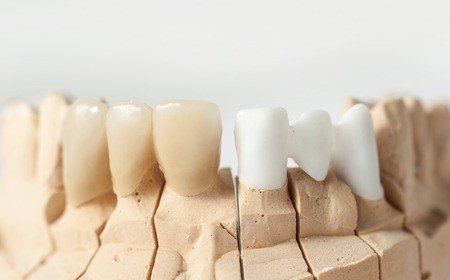Dental Bridges and Your Oral Health Care Routine
Missing a tooth can present problems on several different levels.
Depending where the tooth is located, it can present challenges speaking, eating,
or both. Aesthetically, it can be off putting and make a person very
self-conscious about their appearance. For any one or all of these reasons, a
bridge is often the course of action to correct the problem.
Why a Bridge?
Rather than go through a more expensive tooth implant, a bridge offers a more cost-friendly alternative to get your smile restored. While there are some disadvantages compared to an implant, this is often the method of choice for people missing a single tooth with an otherwise healthy mouth.
Different Types of Bridges
Traditional Bridge – for most people, this is what will be used if they are going to have a bridge done. The bridge is made of two abutment teeth and a replacement tooth. The bridge will be either ceramic or porcelain. The two surrounding teeth will have to be prepped (filed down) for the crown to be installed. The dentist will put on temporary caps while the bridge is being made, then remove the temporary caps when the bridge is ready to be placed.
Cantilever Bridge – when there is not two teeth present on the sides of the missing tooth, a cantilever bridge is used. Rather than having two caps and a replacement tooth (pontic), there is just one abutment tooth and the pontic.
Maryland Bridge – rather than have a traditional bridge done, some will offer a more conservative option with a Maryland bridge, which is a replacement tooth with two metal or porcelain “wings” attached. The wings are cemented to the abutment teeth on both sides of the missing tooth. This avoids the prep work that will need to be done to the abutment teeth.
How Much Will a Bridge Cost?
This is going to depend on your dentist as well as how much work has to be done. For instance, if you have to have a root canal on an abutment tooth as well as having the bridge done, you may be looking at a dental bill of $3,000 or more. On the bright side, most dental plans and alternative dental plans will usually cover a portion of the dental bill.
Maintaining a Bridge
Your dentist and/or hygienist will go over exactly how to care for the tooth, but it is much similar to what you are already, or should be, doing in your daily routine. Flossing and brushing with a fluoride toothpaste is a must but flossing the bridge will take some care. This is made much easier with a water flosser.
If you are avoiding getting a bridge because of the high cost of dental care, consider signing up for our New Hampshire discount dental plan. We offer plans for individuals, families, and small business owners. For more information, click here.
Copyright: franckito
/ 123RF Stock Photo











